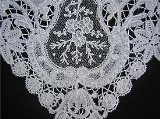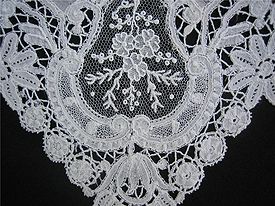
Brussels lace
Encyclopedia


Bobbin lace
Bobbin lace is a lace textile made by braiding and twisting lengths of thread, which are wound on bobbins to manage them. As the work progresses, the weaving is held in place with pins set in a lace pillow, the placement of the pins usually determined by a pattern or pricking pinned on the...
that originated in and around Brussels
Brussels
Brussels , officially the Brussels Region or Brussels-Capital Region , is the capital of Belgium and the de facto capital of the European Union...
. The term "Brussels lace" has been broadly used for any lace from Brussels, however the term strictly interpreted refers to bobbin lace, in which the pattern is made first, then the ground, or réseau, added, also using bobbin lace. Brussels lace is not to be confused with Brussels point, which is a type of needle lace
Needle lace
Needle lace is a type of lace created using a needle and thread to stitch up hundreds of small stitches to form the lace itself....
, though is sometimes also called "Brussels lace".
Brussels lace is made in pieces, with the flowers and design made separate from the ground, unlike Mechlin lace
Mechlin lace
Mechlin lace is a bobbin lace originally produced in Mechelen. It is one of the best known Flemish laces. It is fine, transparent, and looks best when worn over another color. It was made in Mecheln, Antwerp, Lier and Turnhout...
or Valenciennes lace
Valenciennes lace
Valenciennes lace is a type of bobbin lace which originated in Valenciennes, in the Nord département of France, and flourished from about 1705 to 1780. Later production moved to Belgium in and around Ypres. The industry continued onto the 19th century on a diminished scale...
; because of this, the long threads that form the design always follow the curves of the pattern, whereas in bobbin lace
Bobbin lace
Bobbin lace is a lace textile made by braiding and twisting lengths of thread, which are wound on bobbins to manage them. As the work progresses, the weaving is held in place with pins set in a lace pillow, the placement of the pins usually determined by a pattern or pricking pinned on the...
s made all at once, the threads are parallel to the length of the lace. Brussels lace is also distinguished by its réseau or background, the toilé or pattern, and the lack of a cordonnet outlining the pattern. The réseau is hexagonal, with four threads plaited four times on two sides, and two threads twisted twice on the remaining four sides. The toilé can be of two types, the standard woven texture like a piece of fabric, or a more open version with more of the appearance of a netted réseau. This allows for shading in the designs, an effect that was used more in the later designs. In Brussels lace, instead of a cordonnet, the pattern is edged with open stitches, which are then picked up to form the réseau.
Brussels lace is well known for its delicacy and beauty. Originally it was only made from the finest spun
Spinning (textiles)
Spinning is a major industry. It is part of the textile manufacturing process where three types of fibre are converted into yarn, then fabric, then textiles. The textiles are then fabricated into clothes or other artifacts. There are three industrial processes available to spin yarn, and a...
linen
Linen
Linen is a textile made from the fibers of the flax plant, Linum usitatissimum. Linen is labor-intensive to manufacture, but when it is made into garments, it is valued for its exceptional coolness and freshness in hot weather....
thread, which was spun in dark damp rooms to keep the thread from becoming too brittle. Only one ray of light was allowed into the room, and it was arranged so that it fell upon the thread. This fine thread is part of what prevented mechanizing the process of making Brussels lace, as well as the production of it in other regions, as it could not be bought anywhere else. It was also what made the lace so costly. Brussels lace cost more than Mechlin lace
Mechlin lace
Mechlin lace is a bobbin lace originally produced in Mechelen. It is one of the best known Flemish laces. It is fine, transparent, and looks best when worn over another color. It was made in Mecheln, Antwerp, Lier and Turnhout...
, and was in high demand in England and France.
Brussels lace started to be produced in the 15th century, and was first explicitly mentioned in England in a list of presents given to Princess Mary
Mary I of England
Mary I was queen regnant of England and Ireland from July 1553 until her death.She was the only surviving child born of the ill-fated marriage of Henry VIII and his first wife Catherine of Aragon. Her younger half-brother, Edward VI, succeeded Henry in 1547...
at New Years', 1543.
Production
The first step was to spin the flax thread, which was then given to the lace-makers who made the pattern, which was generally of flowers. Then the lace-makers would make the réseau, hooking onto the open edge of the pattern, and working around the pattern to fill the ground.Point d'Angleterre
In 1662, the English ParliamentParliament of England
The Parliament of England was the legislature of the Kingdom of England. In 1066, William of Normandy introduced a feudal system, by which he sought the advice of a council of tenants-in-chief and ecclesiastics before making laws...
passed an act prohibiting the import of all foreign lace, as it was alarmed at how much money was being spent on foreign lace, and wanted to protect the English lace manufacturers. However, the English lace merchants could not supply lace of the same quality as the Brussels lace, and could not get Flemish lace-makers to settle in England. England also produced inferior flax
Flax
Flax is a member of the genus Linum in the family Linaceae. It is native to the region extending from the eastern Mediterranean to India and was probably first domesticated in the Fertile Crescent...
, and thus could not spin the fine thread required, and so the lace produced was of an inferior quality. Since the merchants could not produce the lace at home, they resorted to smuggling, and named the smuggled Brussels lace 'Point d'Angleterre', "English point".
France also had regulations forbidding the importation of foreign lace, so the Brussels lace sold in France was sold under this name. To this day all Brussels lace is called Point d'Angleterre in France. The ladies in the court of Louis XV
Louis XV of France
Louis XV was a Bourbon monarch who ruled as King of France and of Navarre from 1 September 1715 until his death. He succeeded his great-grandfather at the age of five, his first cousin Philippe II, Duke of Orléans, served as Regent of the kingdom until Louis's majority in 1723...
really liked this lace.
When the prohibition ended in 1699, Brussels lace began to become popular again. Queen Anne
Anne of Great Britain
Anne ascended the thrones of England, Scotland and Ireland on 8 March 1702. On 1 May 1707, under the Act of Union, two of her realms, England and Scotland, were united as a single sovereign state, the Kingdom of Great Britain.Anne's Catholic father, James II and VII, was deposed during the...
bought a lot of it, despite the high price. In the courts of George I
George I of Great Britain
George I was King of Great Britain and Ireland from 1 August 1714 until his death, and ruler of the Duchy and Electorate of Brunswick-Lüneburg in the Holy Roman Empire from 1698....
and George II
George II of Great Britain
George II was King of Great Britain and Ireland, Duke of Brunswick-Lüneburg and Archtreasurer and Prince-elector of the Holy Roman Empire from 11 June 1727 until his death.George was the last British monarch born outside Great Britain. He was born and brought up in Northern Germany...
the lace became very popular, despite efforts to encourage native lacemaking. It was used on ruffles, lappets, and flounces. Individual pieces were large, they were made of many one-inch to two and a half-inch pieces, sewn together seamlessly. This type of lace was made until the French Revolution
French Revolution
The French Revolution , sometimes distinguished as the 'Great French Revolution' , was a period of radical social and political upheaval in France and Europe. The absolute monarchy that had ruled France for centuries collapsed in three years...
.
Point plat appliqué
Point plat appliqué ("Applied flat point") is the term given to Brussels lace where the design is appliqueApplique
In its broadest sense, an appliqué is a smaller ornament or device applied to another surface. In the context of ceramics, for example, an appliqué is a separate piece of clay added to the primary work, generally for the purpose of decoration...
d to machine net, instead of using handmade réseau. In 1810, in Nottingham, a machine that made extermely regular linen netting was perfected, and machine-made net became common. From this point on the handmade réseau was only made upon request, and the designs were appliqued directly onto the machine-made net. This resulted in the designs becoming more spread out and less connected.
This type can be distinguished from handmade net, as often the net is not cut away behind the appliqued design, thus the net can be seen on the back of the design. Also, the machine-made net was made of diamond shaped mesh, rather than the hexagonal réseau.
Point Duchesse
Point Duchesse ("Duchess point") is the term for a Belgian lace that does not have a réseau.It was named after the duchess of Brabant, Marie-Henriette of Austria who was a supporter of the lace production.
It is made entirely on the pillow, with the pattern made so that the leaves and flowers naturally join, so there is rarely a bar thrown across to connect them. As there is no réseau, the designs are more continuous.

